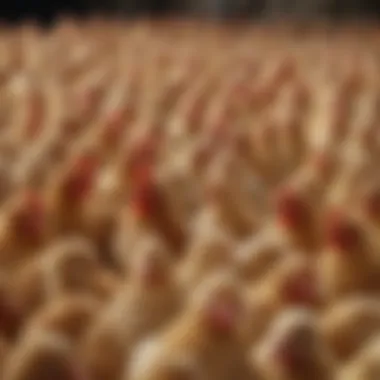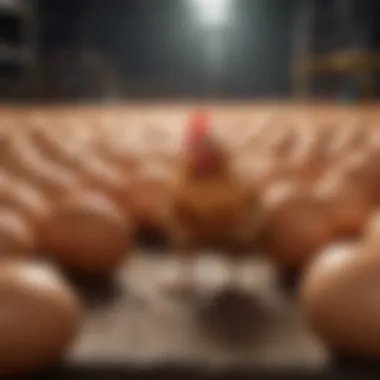Top Breeds for Maximum Egg Production


Intro
Egg-laying chickens are at the heart of poultry production. Their effectiveness in producing eggs affects not only the farmer's livelihood but also the local economy and food supply chain. This article aims to provide an analytical approach to understanding the best breeds for egg production. The secrets to effective egg-laying often lie in the breed selection, management practices, and environmental factors. Thus, understanding these aspects is essential for both avid poultry keepers and agricultural professionals.
Latest Trends in Agriculture
Overview of Current Trends
Agriculture is evolving rapidly, and with it, poultry farming is also adapting to new methodologies and consumer demands. Recent trends show a shift towards breeds that not only lay more eggs but also thrive in various environments. Farmers are now favoring dual-purpose breeds that can offer both meat and eggs, aligning with a holistic approach to farming.
Impact of Technology on Farming Practices
Technology has reshaped how poultry production is viewed and managed. Automated feeding systems, climate control, and even egg collection robots are becoming common in modern poultry farms. This technology enhances productivity, reducing labor costs while improving overall efficiency. Moreover, data analytics is used to monitor hen performance and adjust conditions for optimal egg production. Understanding these tools can significantly impact farming choices.
Factors Influencing Egg Production
In determining the best egg-laying breeds, several key factors come into play:
- Breed Characteristics: Each breed has specific traits influencing egg-laying capabilities.
- Age of the Hen: Young hens typically produce more frequent eggs than older ones.
- Environmental Conditions: Adequate lighting, temperature control, and space are crucial.
- Diet: A balanced diet rich in nutrients is essential for optimal egg production.
An awareness of these influence points will help farmers in choosing the right breeds for their production goals.
Comprehensive Breed Comparison
When it comes to selecting breeds known for high egg production, it is vital to compare their individual characteristics. Here are some notable breeds:
- White Leghorn: Renowned for prolific egg-laying, often producing up to 300 eggs per year.
- Rhode Island Red: A reliable layer with a hardiness that makes it suitable for varied climates.
- Australorp: Not just a great layer, but also well-suited for backyard flocks.
Each breed offers unique advantages depending on specific farming conditions.
End
In summary, understanding the various breeds, their characteristics, and the impact of environmental factors can greatly aid in maximizing egg production. Utilization of modern technology, combined with informed decision-making on breed selection, can pave the way for successful poultry management. This analytical approach to breeding choices will serve as an essential resource for farmers aiming to enhance their egg production strategies.
Prolusion to Egg Laying Chickens
Egg laying chickens are a critical component of poultry production. Understanding their characteristics is essential for anyone involved in farming. Choosing the right breed can lead to improved productivity, higher quality eggs, and overall profitability. In this article, we will explore various aspects of egg-laying chickens, providing insights into their unique features and the factors affecting their performance.
Importance of Choosing the Right Breed
Selecting the appropriate breed of chicken is not just about personal preference. Each breed possesses distinct traits that influence egg production. Factors such as egg size, shell quality, and laying frequency all vary among different breeds. For instance, breeds like the Leghorn are known for their prolific laying, producing a large number of white eggs efficiently. Conversely, other breeds, like the Rhode Island Red, provide a balance of good egg production and hardiness.
Choosing wisely can enhance not only yield but also economic viability. Knowing which breed fits the specific farming context aids in making informed decisions and optimizing resources effectively.
Overview of Egg Production Trends
In recent years, the poultry industry has witnessed notable trends in egg production. There is a growing demand for organic and free-range eggs. As consumers become more health-conscious, they show preference for eggs that are produced sustainably and humanely. Simultaneously, egg producers are adopting advanced breeding techniques. Genetic improvements help to increase egg-laying capacity, with some modern breeds outperforming traditional ones.
Additionally, technological advancements in poultry farming play a significant role. Improved feeding strategies and management practices lead to better egg quality and production rates. It’s essential for farmers to stay updated on these trends to maintain competitiveness.
“The choice of chicken breed fundamentally influences the sustainability and profitability of egg production.”
The dynamics of consumer preferences, coupled with breeding advancements, shape the overall landscape of egg production. To maximize yields, one must consider these evolving trends along with breed characteristics.
Factors Affecting Egg Production
The productivity of egg-laying chickens hinges on multiple factors. Understanding these elements is essential for achieving optimal egg output. Factors affecting egg production can broadly be categorized into genetics, diet, and environment. Each category holds significant influence over the overall performance of hens. By examining these areas closely, poultry producers can make informed decisions, enhancing both productivity and the health of their flock.
Genetics and Breed Characteristics
Genetics plays a foundational role in egg production. Different breeds have varying genetic traits that directly impact their laying capabilities. For instance, the Leghorn breed is renowned for its prolific egg laying, averaging up to 300 eggs annually under optimal conditions. On the other hand, breeds like the Rhode Island Red offer a more balanced approach with good egg-laying capabilities and hardiness.


The hereditary factors affect critical aspects such as egg size, shell quality, and frequency of laying. Choosing the right breed based on these genetic traits can lead to more efficient egg production systems. Thus, understanding breed characteristics is vital in selecting the right hens to meet production goals.
Dietary Requirements
Proper nutrition is essential for maximizing egg production. The diet of laying hens influences their health, egg quality, and overall productivity. Nutrition comprises two main aspects: essential nutrients and supplemental feed options.
Essential Nutrients
Essential nutrients are the foundation of a hen’s diet. Proteins, carbohydrates, fats, vitamins, and minerals are all vital for optimal egg production. Protein, in particular, contributes to muscle development, egg size, and shell strength. Providing a balanced diet with sufficient protein enhances overall egg yield.
The key characteristic of essential nutrients is their direct impact on the physiological processes within hens. For example, calcium is a crucial nutrient that strengthens eggshells. Not meeting the required nutrient levels can lead to poorer egg quality and reduced production rates, thus making it a significant focus for poultry producers.
Supplemental Feed Options
Supplemental feed options serve as an effective strategy to enhance the nutritional value of a hen’s diet. These feeds can include specific proteins or vitamins that may not be sufficiently present in basal feeds. For example, mealworms and alfalfa can boost protein intake.
The key characteristic of these options is their ability to supplement the primary diet, offering additional nutrients that promote health and performance. However, producers must be cautious to avoid over-supplementation, which may lead to health issues. Therefore, balancing basic feed with supplemental options optimizes the hen’s diet and promotes efficient egg production.
Environmental Conditions
Hens thrive in specific environmental conditions, which can significantly impact their laying habits. Two primary aspects to consider are temperature control and lighting schedules.
Temperature Control
Temperature control involves ensuring that hens are kept in a comfortable climate. Extreme temperatures, whether hot or cold, can affect egg production negatively. Optimal temperature ranges, generally between 65°F and 75°F, promote better laying rates.
Acknowledging seasonal changes and managing the henhouse climate can improve comfort and, in turn, productivity. High temperatures can lead to heat stress, hindering egg production. Therefore, effective temperature control is critical for maintaining a steady output.
Lighting Schedules
Lighting schedules are another crucial environmental factor. Hens require a specific amount of light exposure to stimulate laying. The general recommendation is to provide 14 to 16 hours of light per day. Light influences hormone production that triggers egg laying.
Moreover, the quality of light matters as well. Using artificial lighting can help maintain consistent laying patterns, particularly in winter months when natural light diminishes. By managing lighting schedules, producers can effectively enhance egg production, especially during low seasons.
Lazy Layers vs. Prolific Producers
Understanding the differences between lazy layers and prolific producers is essential for anyone involved in poultry farming or egg production. This topic reminds us that not all chickens are created equal when it comes to their egg-laying capabilities. Prolific producers offer consistent output, directly impacting profitability and sustainability in this field. Therefore, knowing the traits and behaviors of each category not only helps in breed selection but also prepares farmers for the management challenges they may face.
Defining Lazy Layers
Lazy layers refer to chicken breeds that exhibit low egg production rates. Generally, these birds may lay eggs less frequently than their more productive counterparts. For example, some of these breeds may produce only a few dozen eggs per year. Factors contributing to low production include genetics, age, and even external stressors like weather conditions or disease. Often, lazy layers can still have desirable traits for pet enthusiasts or hobby farmers, such as docility or ornamental features, but for those focused on efficiency, these birds may not meet their needs.
Characteristics of Prolific Egg Layers
In contrast, prolific egg layers are breeds specially recognized for their higher egg yield. These chickens can produce upwards of 300 eggs annually. Here are some defining characteristics of prolific layers:
- Genetic Superiority: They have been selectively bred for enhanced productivity.
- Consistent Laying Patterns: Many prolific layers tend to adhere to predictable laying schedules, particularly under optimal conditions.
- Health and Resilience: Strong immune systems contribute to their ability to lay eggs regularly.
- Adaptability: These breeds often thrive in different environments, making them easier to manage.
Prolific egg layers not only satisfy the demand for eggs but also bolster the economic viability of poultry operations.
Understanding these characteristics can guide poultry farmers in making informed choices as they develop their flocks. Recognizing the diversity in laying habits will ultimately determine feeding, environmental, and veterinary strategies necessary for successful poultry production.
Top Breeds for Egg Production
The selection of chicken breeds is crucial for successful egg production in any poultry farming endeavor. Understanding the various breeds that excel in this aspect allows farmers to make informed choices that align with their production goals. This section will explore several well-renowned breeds, detailing specific characteristics that impact egg production rates.
Leghorn
Egg Production Rates
Leghorns are famously prolific when it comes to egg production. They can lay over 300 eggs per year, which positions them among the highest producing breeds. This breed reaches maturity quickly, typically starting to lay eggs at around five months of age. One key characteristic that makes Leghorns advantageous is their adaptability to different environments. They are efficient foragers, which can reduce feed costs while still ensuring a high egg output. The main benefit of this breed is its capacity for consistent, high-volume production, making it a first choice for commercial producers.


Health Considerations
Leghorns are generally robust and require less care compared to other breeds. They tend to be more resistant to certain diseases, which contributes to their overall health. They thrive in a variety of living conditions, provided they have sufficient space and proper sanitation. However, their active nature might expose them to injuries if the environment is too confined. When it comes to health, their resilience gives Leghorns a preference among poultry farmers aiming for sustainable egg production.
Rhode Island Red
Pros and Cons
Rhode Island Reds are known for their hardiness and adaptability. They can handle a range of climates and exhibit good laying performance. A key advantage of this breed is its dual-purpose nature; they not only produce a good number of eggs but also serve well as meat birds. On the downside, their egg production rates are generally lower than those of Leghorns, averaging around 200-250 eggs annually. Thus, while they are a solid choice, those focusing solely on egg output might find their numbers somewhat lacking.
Egg Quality
The eggs produced by Rhode Island Reds are recognized for their high quality. Typically, these eggs have a rich, dark brown shell and a well-developed yolk. The nutritional value of the eggs contributes to their popularity among consumers. This breed is not just valued for quantity, but also for quality, demonstrating that sometimes it is better to combine both aspects for a fulfilling production.
Plymouth Rock
Plymouth Rocks offer a good balance between egg production and temperament. They typically lay about 200-250 eggs per year, presenting a reasonable output for backyard farmers. These chickens are sociable and easy to manage, making them suitable for families or educational purposes. However, compared to other prolific layers, their output might not satisfy large-scale producers seeking maximum efficiency.
Sussex
Production Consistency
Sussex hens are known for their consistent egg production. They generally lay around 250 eggs per year, providing reliable output for farmers. The breed adapts well to various raising conditions and can produce eggs even in suboptimal environments. Their consistency in production is a major benefit, ensuring regular supply without sudden drops in output, which can be crucial for small-scale operations.
Raising Practices
Raising Sussex chickens requires attention to their diet and housing needs. They do well in free-range scenarios but can also adapt to confinement. Providing a balanced diet rich in protein and calcium is essential for optimal egg production. Careful management of their environment enables optimal health and productivity, reinforcing their reputation as a preferred breed among dedicated poultry enthusiasts.
Araucana
Unconventional Egg Color
Araucanas are unique due to their ability to lay blue or green eggs. This distinctive trait attracts attention in both local markets and specialty egg producers. Their colorful eggs can command higher prices, presenting an advantage in niche markets. Though egg production might not match that of Leghorns, their novelty can add a competitive edge.
Market Demand
The demand for Araucana eggs fluctuates based on trends and consumer preferences. While they may not produce as many eggs, their distinctive colors create opportunities for market differentiation. As consumers become more interested in diverse products, Araucanas can fit well into this growing demand. However, farmers need to assess their local market conditions to determine if these chickens will be a profitable choice for their specific goals.
In summary, the choice of breed significantly influences egg production outcomes, presenting distinct pros and cons based on individual farm objectives.
Egg Production Chart
The egg production chart serves as a pivotal component within this article, acting as a reference point for individuals aiming to maximize their poultry output. Understanding which breeds are the most efficient egg layers is essential for anyone involved in poultry farming. A clear, visual representation of this data allows farmers and enthusiasts to quickly evaluate the performance of various chicken breeds in terms of egg production. This chart translates complex information into a simplified format, making it much easier to ascertain the best options available for one's specific needs.
Incorporating an egg production chart into discussions around poultry farming provides numerous benefits.
- Quick Reference: Farmers can easily compare breeds side-by-side, assessing factors such as egg yield and production consistency.
- Informed Decision-Making: With the data laid out clearly, stakeholders can make better breeding decisions tailored to their operational goals.
- Performance Tracking: The chart can serve as a baseline to measure the effectiveness of specific breeds over time.
However, it is important to consider that not all breeds perform equally across different environments. Various factors such as climate, feeding practices, and health management directly impact egg production rates. Thus, while the chart provides valuable insights, it is just one tool among many that farmers should utilize in their assessments.
Comparative Analysis of Breeds
A comparative analysis of egg-laying breeds digs deeper into the unique characteristics that define their production capabilities. This involves looking at not just the quantity of eggs produced, but also other factors such as egg size and quality, which are crucial for marketability.
In reviewing breeds like Leghorns, Rhode Island Reds, Plymouth Rocks, and Sussex, critical traits emerge that distinguish them. For example, Leghorns are known for their high production rates but may have a more delicate health profile. On the other hand, Rhode Island Reds, while slightly lower in egg production, tend to show resilience and adaptability, which can be more beneficial to the farmer in the long run.
This nuanced view informs those who are selecting a breed based on their unique circumstances.
Graphical Representation of Data
Graphical representation of egg production data enhances the readability of the information provided in this article. Visual data can effectively communicate trends and comparisons that text alone may fail to convey. Bar graphs, pie charts, and line graphs can illustrate the differences in egg production among breeds clearly and concisely.


For example, a bar graph displaying the average number of eggs produced by each breed over a specific time frame allows for immediate visual comparison. Observers can instantly comprehend which breeds are performing best or where improvements may be needed.
Additionally, using a graphical format can highlight seasonal trends in egg production. For instance, a line graph may reveal how production fluctuates across the year, which can guide farmers in planning their operations, ensuring that they remain responsive to both market demands and environmental challenges.
Visually compelling data presentations are not only more engaging but also support better retention of information, making them essential for educational purposes.
The integration of visual aids in egg production analysis can drastically improve understanding and decision-making processes.
Through careful consideration of both the analytical text and visually represented data, poultry farmers can develop a comprehensive insight into the most effective egg-laying breeds available.
Best Practices for Maximizing Egg Production
Maximizing egg production is critical for both small-scale poultry operations and larger agricultural endeavors. Understanding the best practices in this area can make a significant difference in overall yield and profitability. It is not merely about raising chickens; it involves a synergy of adequate nutrition, proper environmental conditions, and consistent health assessments. Poultry enthusiasts and farmers should focus on these practices not just for their immediate benefits, but also to foster sustainable growth in poultry production.
Nutritional Strategies
Nutritional strategies are essential for ensuring optimal egg production. Chickens require specific dietary components, and their diet must provide sufficient nutrients to support consistent egg laying. The primary nutrients include protein, calcium, and vitamins. High-quality layers' feed often contains balanced ratios of these components.
- Protein is crucial as it forms the basis of the egg. A diet inadequate in protein can lead to lower egg production and weaker eggshells.
- Calcium is particularly necessary for strong eggshell formation. Insufficient calcium intake can lead to thin shells, increasing breakage and reducing marketability.
- Vitamins like A, D3, and E also play a role in reproductive health. These vitamins support various bodily functions, including egg quality and hen vitality.
Supplementing the diet with grit aids in digestion, allowing hens to process their food more effectively. Additionally, providing access to fresh greens can enhance their diet, offering essential micronutrients and improving overall health.
Environmental Management
The environment where chickens are raised significantly impacts their egg production levels. Proper management of their habitat helps create conditions that are conducive to laying. Here are some crucial aspects to consider:
- Temperature Control: Chickens thrive in specific temperature ranges. Extreme heat or cold can stress hens, leading to decreased production. Maintaining a stable and comfortable temperature is vital.
- Lighting Schedules: Chickens have natural rhythms affected by light exposure. Implementing artificial lighting regimes can stimulate laying by mimicking longer daylight hours. A balanced light schedule (around 14-16 hours a day) can enhance production levels.
- Space Requirements: Ensuring adequate space prevents overcrowding and stress. Each hen requires sufficient room to roam, feed, and lay eggs comfortably.
These environmental elements require attention and adjustment as they vary throughout the seasons. Special care must be taken during changes in weather.
Regular Health Assessments
Conducting regular health assessments is fundamental to maximizing egg production. This practice helps in early detection and management of health issues that could hinder productivity. Effective health monitoring involves several steps:
- Routine Inspections: Regular checks for signs of distress, illness, or unusual behaviors can catch health issues before they escalate. Look out for weight loss, feather loss, or lethargic behavior.
- Vaccinations: Vaccination protocols should be established to protect against common diseases, which can greatly impact egg production. Consult veterinary guidelines for appropriate vaccines.
- Biosecurity Measures: Implementing strict biosecurity measures safeguards against external infections and minimizes the risk of disease. Keeping the poultry area clean and limiting visitor access can help maintain overall flock health.
Regular health assessments lead to healthier birds, ultimately resulting in improved egg quality and quantity. Such diligence builds a robust foundation for successful poultry production.
Culmination
In the realm of poultry production, understanding egg-laying chickens is crucial. This conclusion synthesizes the significant points discussed throughout the article. Choosing the right breed not only affects productivity but also encompasses various factors such as genetics, diet, and environmental adequacy. These elements play integral roles in determining the success of an egg-laying operation.
By selecting breeds such as Leghorns or Rhode Island Reds, poultry enthusiasts can optimize production based on specific needs. Each breed with its unique characteristics brings different advantages and challenges. This nuanced understanding highlights that informed decision-making is key.
Benefits of Focusing on Top Breeds:
- Increased production rates.
- Improved egg quality.
- Economically viable operations.
A conscientious approach to these aspects results in higher profitability and sustainability in poultry farming. This article thus serves as an essential reference for both novice and experienced farmers.
Summarizing Key Insights
This article has emphasized the various factors influencing egg production. Key insights include:
- Breed Selection: Certain breeds are more prolific and resilient.
- Nutritional Needs: The right diet could enhance egg yield significantly.
- Environmental Management: Maintaining optimal conditions affects lay rates and hen health.
Further, it has been highlighted that regular health assessments can prevent declines in productivity. Overall, the analysis provided is geared towards making informed choices, benefiting ones’s poultry endeavors.
Future Considerations in Poultry Breeding
As agricultural practices evolve, so too must the strategies for poultry breeding. Future considerations include:
- Genetics Advancements: Research into genetic modifications may lead to more resilient breeds.
- Sustainability Practices: Enhancing eco-friendliness in poultry production ensures long-term viability.
- Technological Innovations: Adopting new feeding and housing technologies could improve production rates.
Addressing these areas could potentially reshape the poultry industry. The combination of knowledge acquired from this article and forward-looking strategies may set benchmarks for future poultry production.
"Informed decisions lead to successful poultry outcomes."
These insights contribute to both current practices and future directions in poultry breeding, positioning farmers advantageously in the marketplace.







